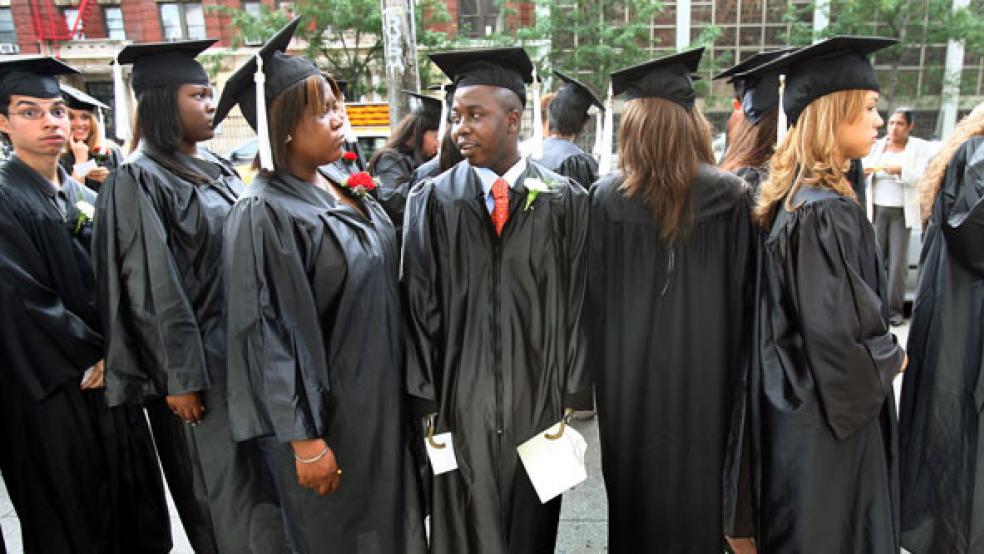In Nina Kadjar’s sophomore year at the University of Texas, her mother ran across a webpage describing a new source of funds to pay for school. A little-known state program, called B-on-Time, could provide her daughter a zero-interest annual loan of between $6,000 and $7,000, with payments to start after graduation. That would make a significant dent in the $24,000 a year that Nina Kadjar needed for tuition and expenses. But the program had an even better twist—if she could get her degree in four years and maintain a B average, the loan would be completely forgiven.

RELATED: 11 Public Universities with the Worst Graduation Rates
As the federal government and states look for ways to control rising tuition and student debt, they’re focusing increasingly on schools’ “degree productivity,” or how often and how quickly they move students to graduation. States are experimenting with how to help more students matriculate, and a few are trying something new—using the power of the purse to motivate them to get their bachelor’s degrees in four years.
Productivity is the new frontier in higher education. Back in the 1940s after the G.I. Bill passed, the focus was on ensuring access to college, says Stan Jones of Complete College America, nonprofit that advocates reforms designed to graduate more students. But with average tuition up 63 percent just since 2000, the conversation has turned from access to efficiency, with students in need of more financial aid than ever at a time when the federal and state budgets are in dire straits. “If we could get more folks to complete on time, we could make college much more affordable for families and lessen taxpayer costs,” says a source at the U.S. Department of Education.
Jones says universities and colleges need to do more than get people into school—they must turn out graduates, and quickly. In 1972, students took 4.3 years on average to get a bachelor’s degree; when a followup study was done in 1992, that had increased to 4.6 years. Today, the government uses a different metric to calculate graduation time, but data released earlier this year show that today’s four-year graduation rate across colleges is just 38 percent. “You always see [schools’] press releases about how many students they enrolled in the fall,” says Jones. “But they never tell you their graduation rates.”
There’s evidence that at least part of the increase in graduation times stems from students applying themselves less than in the past. A 2009 paper by two economists at the University of California found steep declines in the average weekly study time of full-time college students at four-year colleges—from about 24 hours per week in 1961 to about 14 hours per week in the 2000’s.
But many students are also working significant hours to pay for school and so find it hard to take a full load—45 percent of students at 4-year schools work more than 20 hours a week. Working that amount hurts their grades, according to one study. A 2010 report by the Southern Regional Education Board also documented schools’ failure to offer courses in a workable sequence. And students are taking too many credits—Complete College America’s data show that they’re graduating with 136.5 credits instead of the 120 they normally need for a four-year degree. That could be because at flagship schools like the University of Massachusetts, many students change majors or graduate with more than one.
RELATED: Why America’s College Students Don’t Graduate
To help students focus on school and stick to one degree, states are offering them an array of financial incentives. Indiana University-Kokomo is giving steep tuition discounts to students who take a full load each year—if students stay on track, by the end their savings are equal to a full year’s tuition. Three other Indiana state schools have cut the cost of their summer classes by as much as 25 percent to encourage students to use the vacation months to make progress.
Texas schools are offering B-on-Time because it’s required by a 2003 state law. The program is financed with a combination of state money and a small percentage of tuition money that universities must set aside. In Indiana, schools are trying these experiments because their funding is tied to their productivity. Five percent of the overall state allocation for higher education in Indiana—$61 million—is awarded based on schools’ performance in making sure students actually get degrees and graduate on time.
A few states are using sticks instead of carrots. In West Virginia, the recipients of a merit-based state scholarship have to take a full load each year or lose their money. And in 2010, Arkansas began doing the same with its merit scholar program.
Jones says programs that incentivize students to finish quickly make particular sense when state dollars are scarce as they are now. If you have limited state funding, “you’re better rationing for students who show they can progress toward a degree in a timely way,” he says. The Texas students enrolled in B-on-Time have more than double the on-time graduation rate of students not in the program—39 versus 19 percent. An analysis of West Virginia’s program found it raised on-time graduation rates by almost 7 percent, according to the U.S. Department of Education.
Of course, students have to make sacrifices to save money. Nina Kadjar made it—she’s graduating this month, less than 4 years after she started school, so her B-on-Time loan of $19,000 will be canceled. But she carried a full load of classes every term but one. She went to class during summers. And she dropped her idea of getting a double major when a key course wasn’t available when she needed it.
Was the money worth all of that? “Right now I’d say yes,” Kadjar says. She hasn’t tallied up her total school debt, but whatever it is, “$19,000 is a huge help.”





